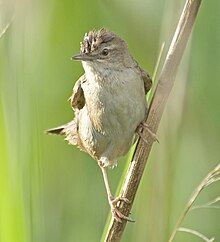| Savi's warbler | |
|---|---|

| |
| Scientific classification | |
| Domain: | Eukaryota |
| Kingdom: | Animalia |
| Phylum: | Chordata |
| Class: | Aves |
| Order: | Passeriformes |
| Family: | Locustellidae |
| Genus: | Locustella |
| Species: | L. luscinioides
|
| Binomial name | |
| Locustella luscinioides (Savi, 1824)
| |

| |
| Range of L. luscinioides Breeding Passage Non-breeding
| |
Savi's warbler (Locustella luscinioides) is a species of Old World warbler in the grass warbler genus Locustella. It breeds in Europe and the western Palearctic. It is migratory, wintering in northern and sub-Saharan Africa.
This small passerine bird is found in reed beds, usually with some bushes. Three to six eggs are laid in a nest in reeds. The adult has an unstreaked grey-brown back, whitish grey underparts and a lack of throat streaks, which is a distinction from the river warbler. The sexes are identical, as with most warblers, but young birds are yellower below. Like most warblers, it is insectivorous. This is not a shy species, but can be difficult to see in the reeds except sometimes when singing.
The is a monotonous mechanical insect-like reeling, often given at dusk. It is similar to the song of other species in the group, but is generally faster and deeper and bears a strong resemblance to that of Roesel's bush-cricket.
- ^ BirdLife International (2016). "Locustella luscinioides". IUCN Red List of Threatened Species. 2016: e.T22714684A87560838. doi:10.2305/IUCN.UK.2016-3.RLTS.T22714684A87560838.en. Retrieved 13 November 2021.
